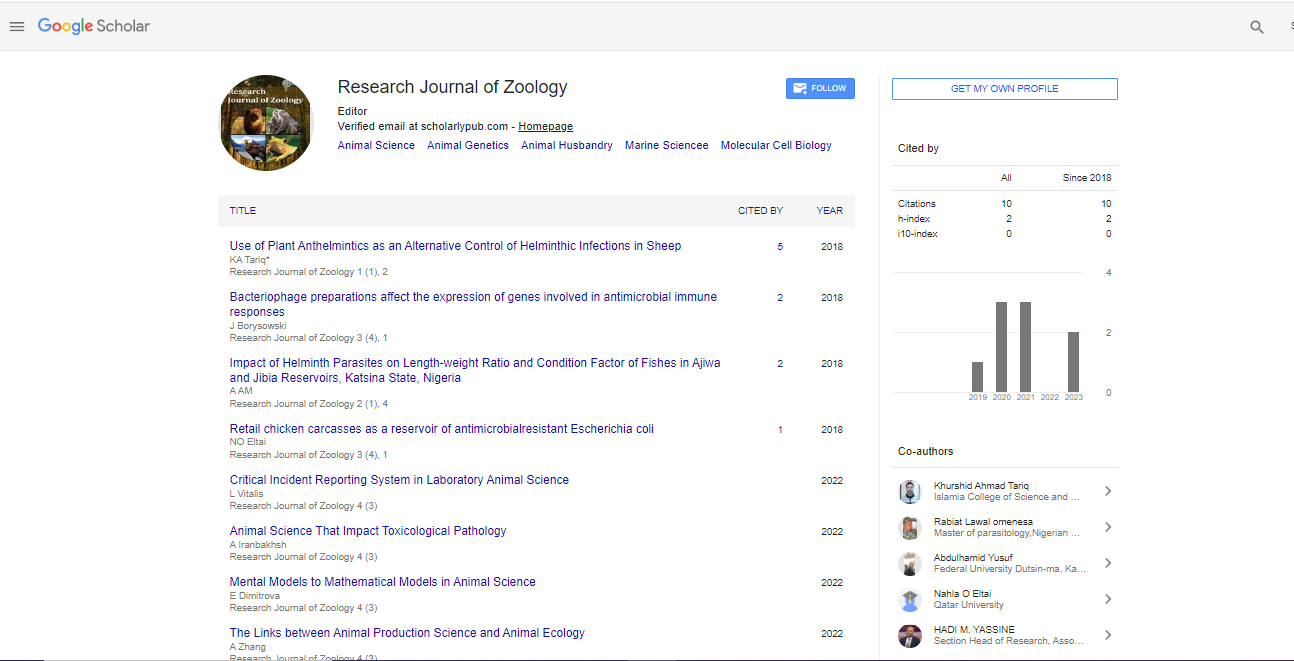Short Communication, Res J Zool Vol: 5 Issue: 2
Allantois: A Significant Embryonic Structure with Multiple Functions
Ripla Corbel*
1Department of Zoology, University of Sao Paulo, Sao Paulo, Brazil
*Corresponding Author: Ripla Corbel,
Department of Zoology, University of Sao
Paulo, Sao Paulo, Brazil
E-mail: corbelripla@gmail.com
Received date: 15 May, 2023, Manuscript No RJZ-23-107131;
Editor assigned date: 17 May, 2023, PreQC No RJZ-23-107131 (PQ);
Reviewed date: 01 June, 2023, QC No RJZ-23-107131;
Revised date: 08 June, 2023, Manuscript No RJZ-23-107131 (R);
Published date: 16 June, 2023, DOI: 10.4172/Rjz.1000089
Citation: Corbel R (2023) Allantois: A Significant Embryonic Structure with Multiple Functions. Res J Zool 5:2.
Description
The allantois is a vital embryonic structure found in many vertebrate animals, including birds, reptiles, and mammals. It develops as part of the extraembryonic membranes during early embryonic development. The allantois serves several essential functions, contributing to the proper development and survival of the embryo.
Anatomy and formation of allantois
The allantois arises during gastrulation, a fundamental stage in embryonic development when the single-layered blastula transforms into a gastrula with three primary germ layers. During this process, cells from the endoderm and mesoderm layers migrate towards the embryonic pole, where they form a sac-like structure known as the allantois. The allantois is initially positioned within the extraembryonic coelom, a cavity located outside the embryo [1-3].
In avian and reptilian embryos, the allantois develops rapidly and becomes an elongated, tubular structure extending from the embryo's hindgut. In mammals, including humans, the allantois starts as a small outgrowth from the hindgut, which eventually expands and fuses with the chorion, another extraembryonic membrane. In mammals, the allantois is important for the formation of the placenta [4-6].
Functions of allantois
Waste management: One of the primary functions of the allantois is to store and manage waste products produced by the developing embryo. In birds and reptiles, the allantois acts as a storage sac for waste nitrogenous products, primarily uric acid, a compound with low water solubility. This prevents the accumulation of toxic substances in the developing embryo, ensuring its well-being [7].
Respiratory gas exchange: The allantois in some animals, particularly birds, also plays a role in respiratory gas exchange. As the allantois expands, it comes into close proximity with the eggshell, allowing the exchange of gases like oxygen and carbon dioxide between the embryo and the external environment [8].
Nutrient transport: In mammals, the allantois contributes to the formation of the placenta, a vital structure that facilitates nutrient and gas exchange between the maternal bloodstream and the developing embryo. The allantois fuses with the chorion to progress the chorioallantoic membrane, which contacts the uterine wall and facilitates nutrient uptake from the mother.
Protection and cushioning: The allantoic cavity provides a protective and cushioning environment for the developing embryo. In some animals, such as reptiles and birds, the allantois may also act as a reservoir for embryonic fluids, helping to maintain a stable and hydrated environment [9].
Clinical significance of allantois in humans
In humans, remnants of the allantois persist in the form of the urachus, a fibrous cord extending from the apex of the bladder to the umbilicus. During fetal development, the allantois is responsible for connecting the bladder to the umbilical cord. After birth, the urachus normally closes, becoming a non-functional vestigial structure. However, in some cases, it may fail to close properly, leading to a condition known as a patent urachus, which requires medical attention [10].
Conclusion
The allantois is an incredible embryonic structure found in various vertebrate animals, serving diverse functions important for the successful development and survival of the embryo. From waste management to nutrient transport and respiratory gas exchange, the allantois plays a pivotal role in facilitating embryonic growth and preparing the embryo for life outside the protective environment of the egg or uterus. Understanding the allantois sheds light on the complexity of embryonic development and the remarkable adaptations that have evolved across different species throughout the animal kingdom.
References
- Le BD, Debut M, Berri CM, Sellier N, Lhoutellier VL et al (2008) Chicken meat quality: genetic variability and relationship with growth and muscle characteristics. BMC Genet 9: 53.
- Beauclercq S, Desbarats LD, Antier CH, Collin A, Tesseraud S et al (2016) Serum and muscle metabolomics for the prediction of ultimate pH, a key factor for chicken-meat quality. J Proteome Res 15(4) :1168–1178.
- Petit A, Sophie RG, Lydie ND, Estelle CA, Pascal C et al. (2022) Nutrient sources differ in the fertilised eggs of two divergent broiler lines selected for meat ultimate pH. Sci Rep 12(1): 5533.
- Wu G, Bazer F, Datta S, Johnson GA, Li P et al. (2008) Proline metabolism in the conceptus: Implications for fetal growth and development. Amino Acids 35(4): 691–702.
- Busch M, Milakofsk L, Hare T, Nibbio B, Epple, A (1997) Regulation of substances in allantoic and amniotic fluid of the chicken embryo. Comp. Biochem. Physiol A Physiol 116(2) :131–136.
- Noble RC, Cocchi (1990) M Lipid metabolism and the neonatal chicken. Prog Lipid Res 29 (2): 107–140.
- Da S. Clara D, Aurélien B, Philippe M, Magali C et al. (2019) The unique features of proteins depicting the chicken amniotic fluid. Mol Cell Proteom 18(1): S174–S190.
- Bourdin P, Laurent G, Lydie N, Camille D, Sylvie Bet al. (2021) Maternal rat metabolomics: Amniotic fluid and placental metabolic profiling workflows. J Proteome Res. 20(8): 3853–3864.
- Zhu H, Guo J, Wang H, Gu D, Wang D et al. (2022) Developmental changes of free amino acids in amniotic, allantoic fluids and yolk of broiler embryo. Br Poult Sci 63 (6): 857–863.
- Zhang L, Qi Y, ALuo Z, Liu S, Zhang Z et al. (2019) Betaine increases mitochondrial content and improves hepatic lipid metabolism. Food Funct 10 (1) :216–223.
 Spanish
Spanish  Chinese
Chinese  Russian
Russian  German
German  French
French  Japanese
Japanese  Portuguese
Portuguese  Hindi
Hindi 
